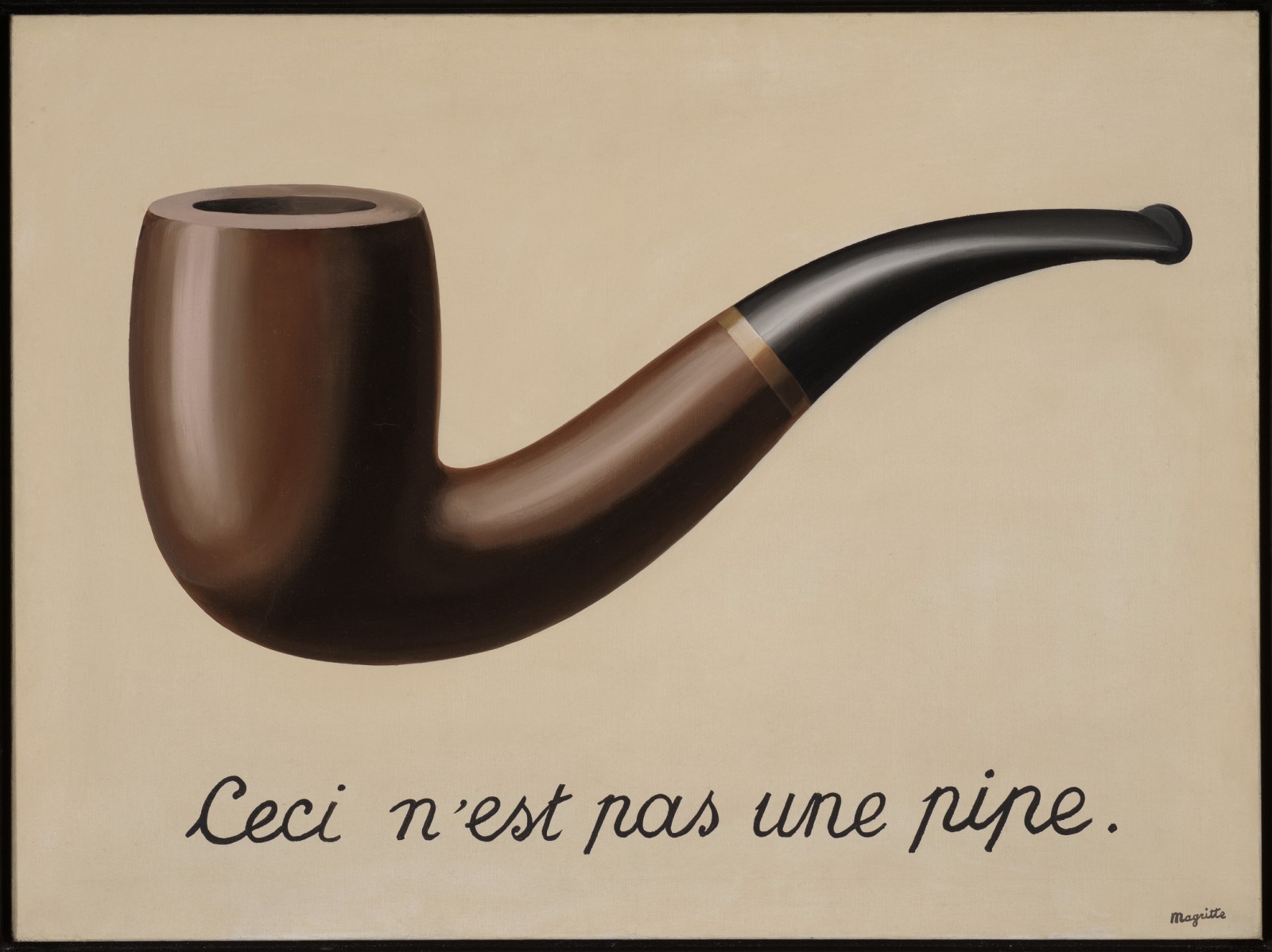We are all familiar with the stages of our wondrous dreams, floating above and behind reality. Connecting with otherworldly and practical things in the quiet of our sleep.
We find hidden meanings and feelings that resonate with our life and the person that we are. And a person who paints or creates art with such loose and strong threads with likewise subjects is known as a surrealist.
The Surrealist René Magritte is widely regarded as one of the most famous and influential artists of the 20th century for the adoption of surrealism philosophy in his paintings.
His clever use of ordinary objects has become so well-known that they are instantly recognizable even to those with only a cursory knowledge of modern art. The man who made the picture of ‘The Pipe’ is one of the 20th century’s most well-known artists.
We present you with some interesting facts about René Magritte, and his life & works.
What is Surrealism
Surrealism as a concept came into being in the 1920s.
A cultural movement associated with art and writings that sought to re-establish the connections between dream and reality, and the world and our minds.
Such artists paint scenes and paintings, which are ‘weird’, or ‘thought-provoking’ for others, creating hyper-realistic conceptual scenes from everyday art.
Today as well, surrealism flourishes with thousands of surreal photographers and artists trying to make a mark in the field with their out-of-the-box visions and creations.
Artists today credit such success of the movement to a variety of previous painters and artists, but one name that stands out is René François Ghislain Magritte.
Known as René Magritte, a painter who largely influenced the theme of surreal art into today’s pop, minimalist and conceptual art.
René Magritte – The Man Who Made “The Pipe” Painting [His Life & Work]
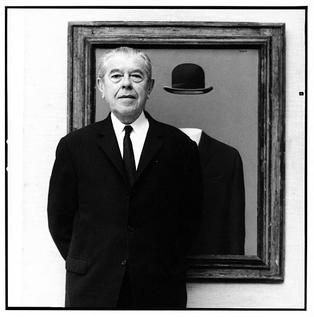
Magritte was born in Lessines, Belgium, on November 21, 1898.[*]
His father was a manufacturer, which provided his family with a comfortable life. Yet they were not completely susceptible to financial problems, which led to them moving around a lot.
A tragedy struck Magritte’s life when in 1912, his mother committed suicide by drowning in a river. Thus Magritte tried seeking solace in books, films, and paintings. He graduated from an art school in Brussels.
After his yearly military training, he got married and worked in commercial advertising to earn a livelihood while he experimented with his painting.
By the mid-1920s he began to paint in the surrealist style and became known for his art. This allowed him to take up his thought-provoking art full time.
René Magritte was highly influenced by Giorgio de Chirico in his use of perspective and architecture in his paintings. His works are noted for their idiosyncratic use of imagery.
Magritte’s work is noted for its often eccentric imagery and off-kilter sense of humor, as well as its slightly naive and somewhat simplistic effect.
Magritte died of pancreatic cancer on 15 August 1967, aged 68.
A museum to his name was opened in Brussels on 30th May 2009 and is called The Magritte Museum.
The place displays some 200 original Magritte paintings, drawings, and sculptures including The Return, Scheherazade, and The Empire of Lights.
It is known to be the biggest Magritte archive to exist and also contains his experiments with photography from 1920 on and the short surrealist films he made from 1956 onward.
Anamnese Surrealism short film was one of the most popular short films by Rene Magritte.
Surrealist René Magritte’s Most Famous Paintings and Their Meaning
René Magritte was a Belgian surrealist artist who is most famous for his paintings that have enigmatic and mysterious meanings.
His most famous paintings are “The Son of Man”, “The Treachery of Images”, and “The False Mirror”. René Magritte’s works often share the concepts of being both “reality” and “unreality”.
He made about 370 paintings during his lifespan, below is a list of 40 famous René Magritte paintings.
- The Annunciation
- The Blank Signature
- Sixteenth of September
- Natural Encounters
- On the threshold of liberty
- The Balcony
- The Voice of Space
- Memory of a Voyage
- The Lost Jockey
- The Gradation of Fire
- The Art of Living
- The Battle of the Argonne
- Collective invention
- The six elements
- The Glass House
- The Muscles of the Sky
- Not to Be Reproduced
- Personal Values
- Popular Panorama
- Elective Affinities
- Ready Made Bouquet
- The Birth of the Idol
- Son of Man
- The Invention of Life
- The Treachery of Images
- Homage to Mack Sennett
- The Tomb of the Wrestlers
- The Therapist
- The Lovers
- Man in a Bowler Hat
- The Pilgrim
- The false mirror
- La Clairvoyance
- The Mysteries of the Horizon
- Attempting the Impossible
- The Endearing Truth
- The Empty Picture Frame
- The Central Story
- The Listening Room
- The Banquet
Let’s explore a couple of the most popular paintings of the Surrealist René Magritte.
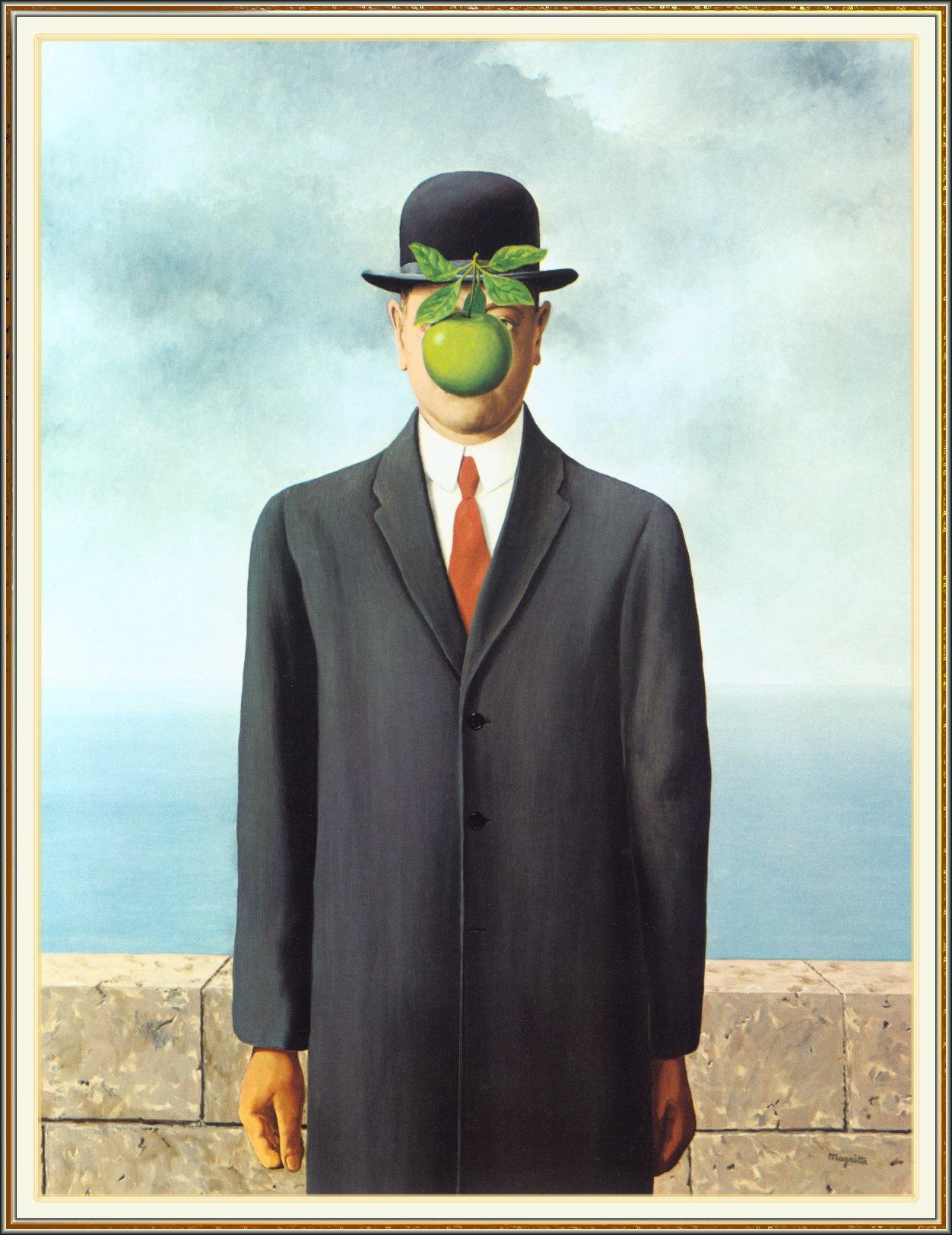
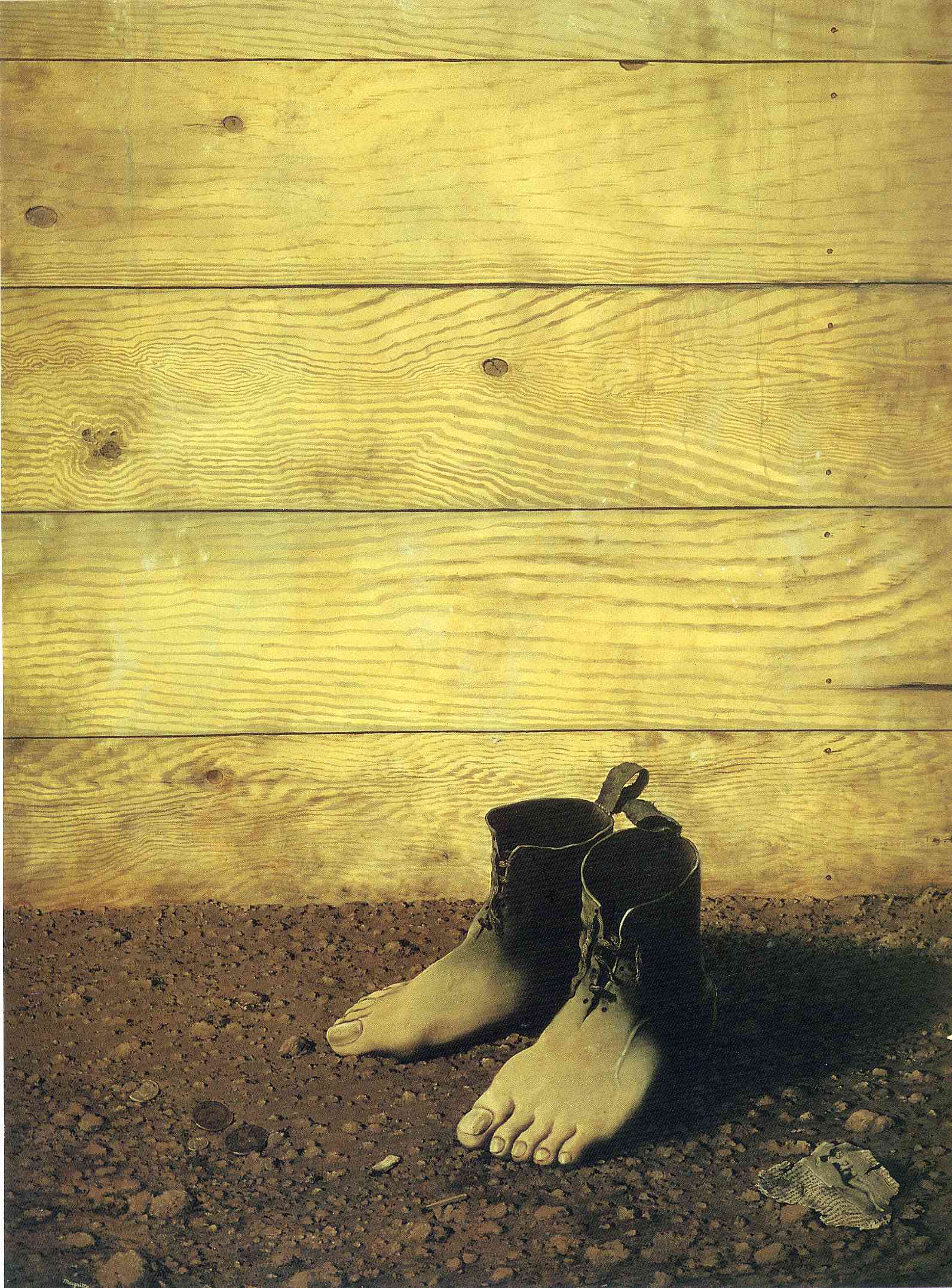
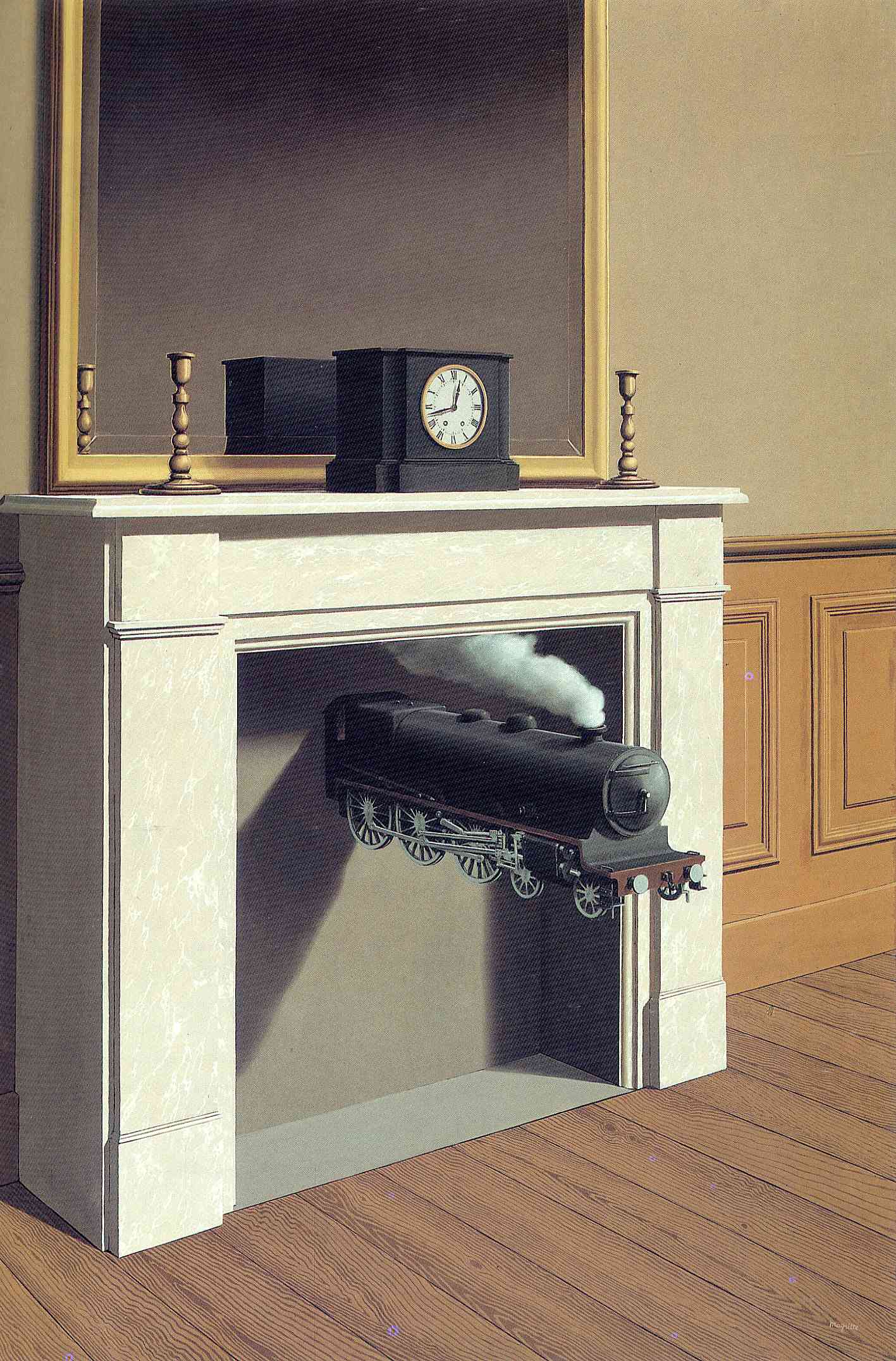
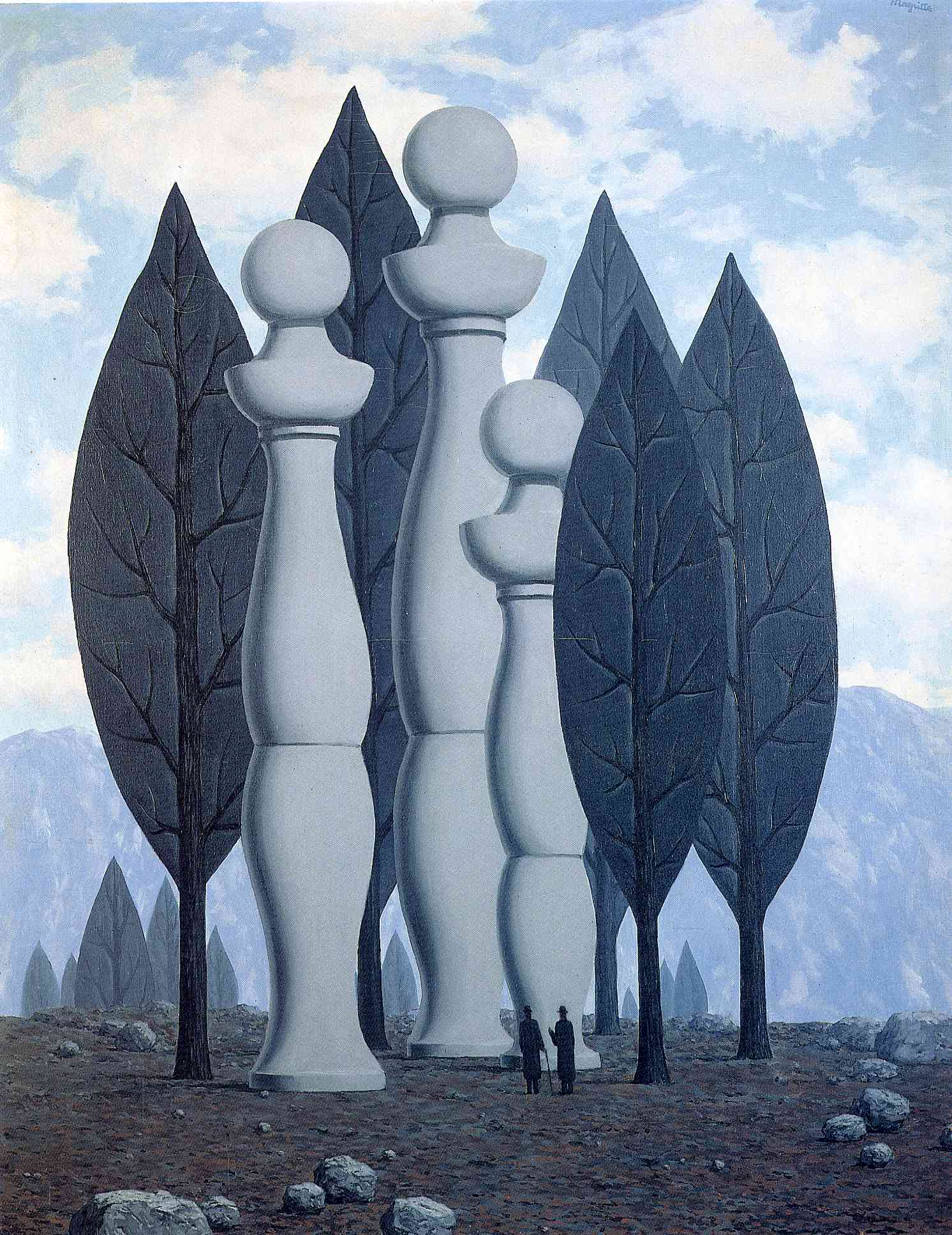
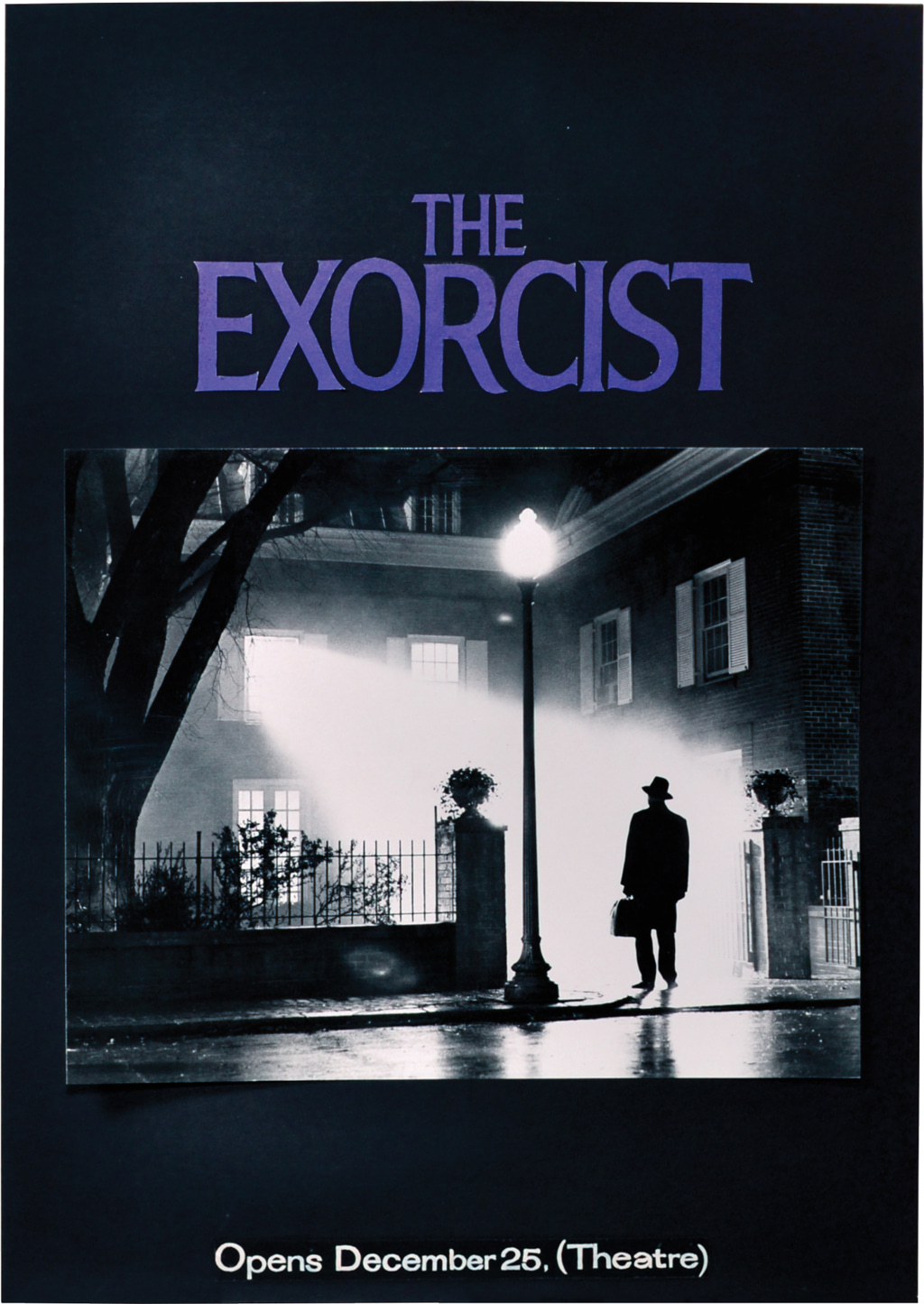
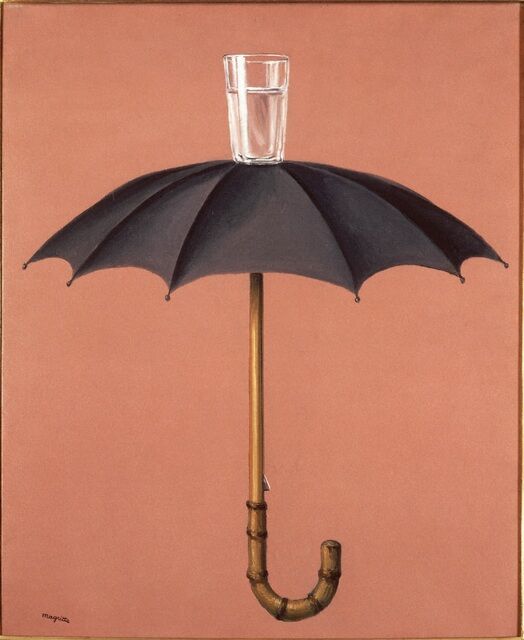
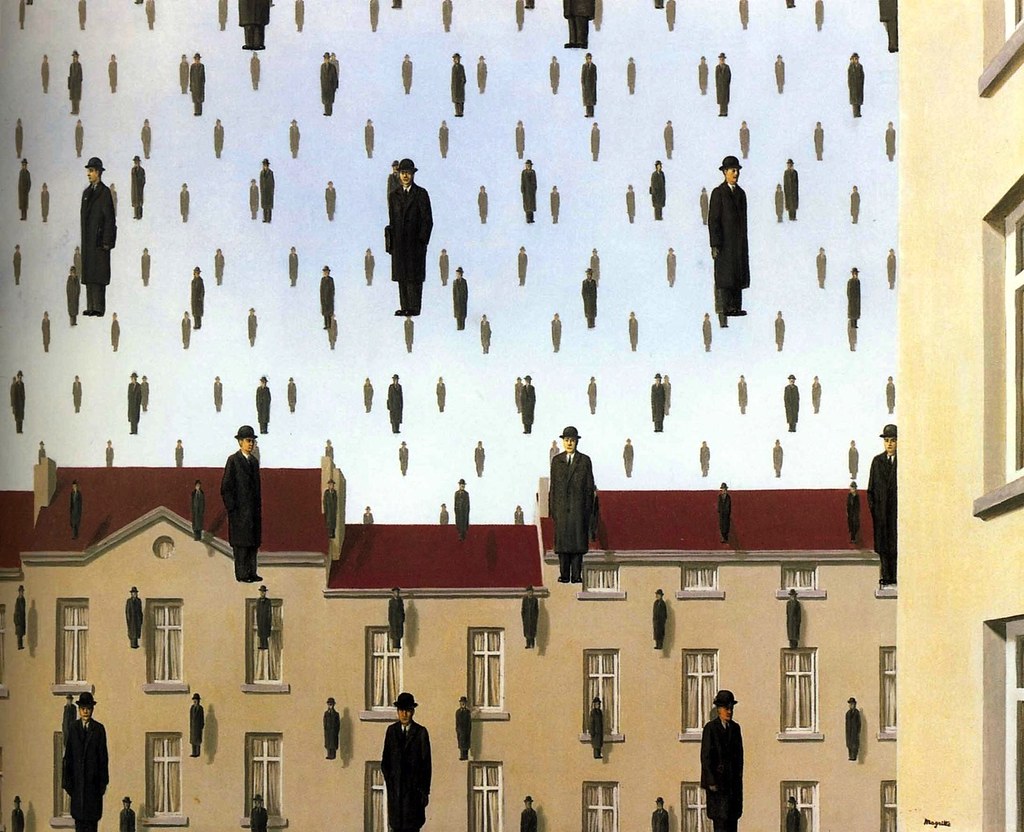
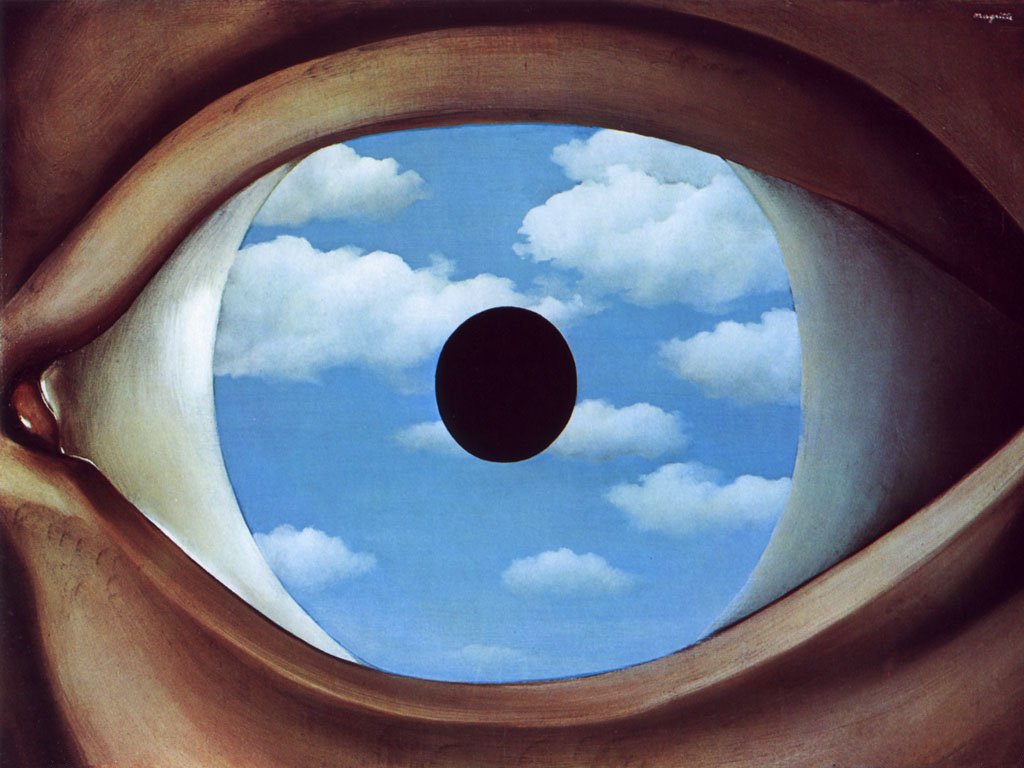
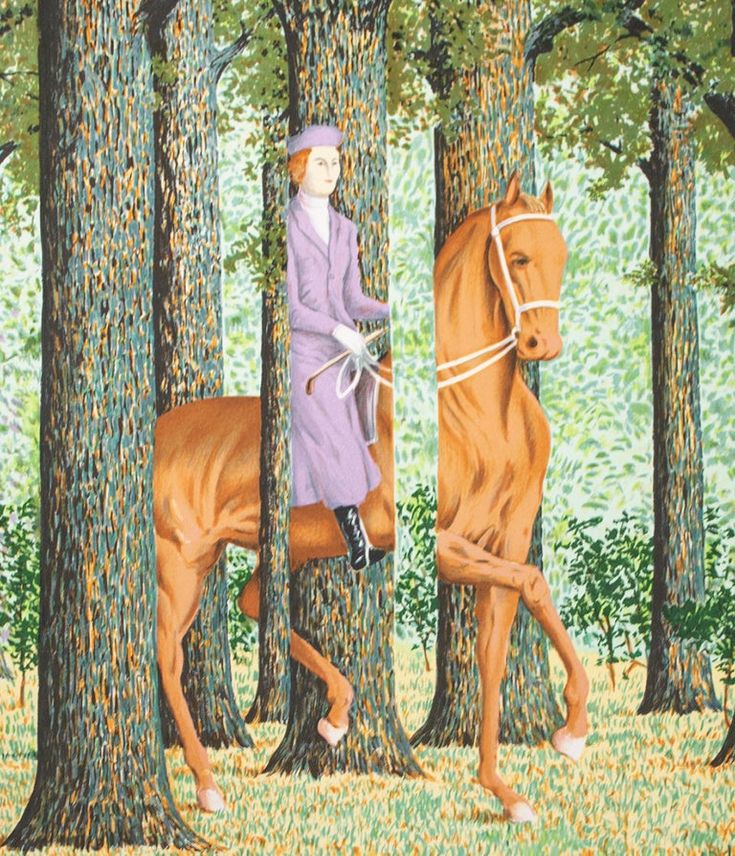
The Treachery of Images (The Treason of Images) – “The Pipe” Painting
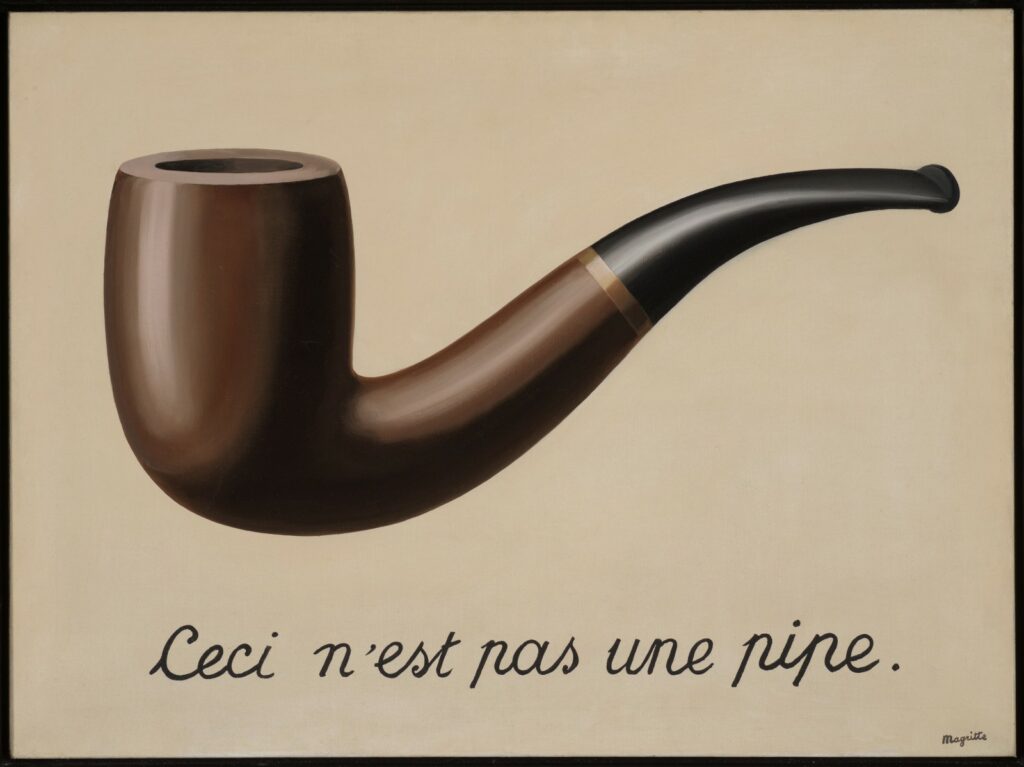
A beautifully clear painting of a pipe, upon a clear background, with the words “Ceci n’est pas une pipe.”, French for “This is not a pipe,” underneath it. This makes one wonder, right? Why is this not a pipe? What is this treachery?
When asked to speak about his very famous painting, he replied, “The famous pipe”. How people reproached me for it!
And yet, could you stuff my pipe? No, it’s just a representation, is it not?
So if I had written on my picture ‘This is a pipe’, I’d have been lying!”
So, the map is not the territory, and the word is not the thought.
A picture of a pipe is not a pipe.
Makes amazing sense when one finally gets the not so simple idea behind the seemingly simple image.
The treason of images continues to be one of the most celebrated works of art in the modern world.
It is currently on display at the Los Angeles County Museum of Art.
The treason of images has widely appeared in pop culture references, such as the book ‘The Forbidden Game’ by L.J. Smith, and the movie ‘The Fault in Our Stars’.
The Lovers, 1928
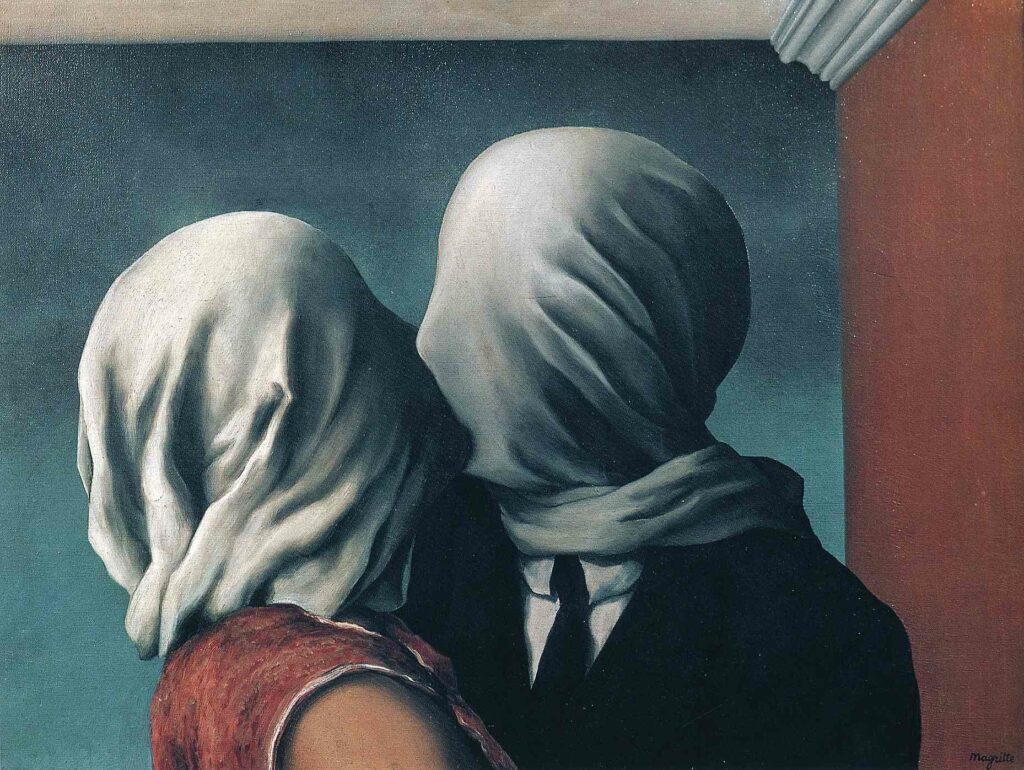
“The lovers” is another famous and widely discussed painting by Magritte.
The enigmatic drawing of two lovers kissing with opaque clothes completely covering their faces is something that has been theorized by different people in different interpretations.
Some say, that the picture represents the loneliness of two people.
Embraced in such intimacy and still not completely intimate.
While others say that the picture represents the opposites of company and loneliness.
The cloth around the protagonists’ faces is also said to have been influenced by Magritte’s mother’s suicide.
While her body was dragged out of the water her wet nightgown covered her face.
However, Magritte has denied any such interpretations, calling a mystery to have no meaning, for that is the purpose of a mystery, to be unknown.
One of the interpretations that are also widely believed is the fact that no one shows their true side to anyone, even to their intimate lovers or counterparts.
The painting currently sits in the Museum of Modern Art, New York, USA.
Here is a video comprised of popular paintings made by Rene Magritte.
Top 10 Famous Quotes by René Magritte
René Magritte has been called one of the most important artists to emerge from Surrealism and was famous for his paintings that depict ordinary objects in an unusual or mysterious way.
You can even notice “The Surrealism” philosophy in his quotes. Here are some of the most famous Rene Magritte’s quotes:
Everything we see hides another thing, we always want to see what is hidden by what we see.
~ René Magritte
If the dream is a translation of waking life, waking life is also a translation of the dream.
~ René Magritte
The mind loves the unknown. It loves images whose meaning is unknown, since the meaning of the mind itself is unknown.
~ René Magritte
Art evokes the mystery without which the world would not exist.
~ René Magritte
My painting is visible images which conceal nothing… they evoke mystery and indeed when one sees one of my pictures, one asks oneself this simple question ‘What does that mean’? It does not mean anything, because mystery means nothing either, it is unknowable.
~ René Magritte
To be a surrealist means barring from your mind all remembrance of what you have seen, and being always on the lookout for what has never been.
~ René Magritte
Only thought can resemble. It resembles by being what it sees, hears, or knows; it becomes what the world offers it.
~ René Magritte
Life obliges me to do something, so I paint.
~ René Magritte
We must not fear daylight just because it almost always illuminates a miserable world.
~ René Magritte
The present reeks of mediocrity and the atom bomb.
~ René Magritte
Interesting Rene Magritte Facts
René Magritte (1898-1967) was a Belgian painter, sculptor, and poet.
He is best known for his surrealist style paintings and his works of painting with images that appear to be real, but that are actually distorted images of objects and events.
Magritte’s surrealist style is often characterized by a portrayal of human figures as otherworldly and ambiguous, as in The Son of Man, which shows a man’s face in a distorted, upside-down position.
Magritte discussed life very ironically saying “I can imagine a sunny landscape under a night sky; only a god is capable of visualizing it and conveying it through the medium of paint, however. In the expectation that I will become one, I am dropping the project.”
1. His Work Inspired Many Songs
Magritte is a major influence on many musicians. John Cale wrote a song titled “Magritte” in 2003.
Inspired by two photos of Rene Georgette, the song “René and Georgette Magritte with Their Dog After the War” was written by Paul Simon in 1983.
His paintings even inspired many album covers including-
- Golconda (1953) inspired the cover of Racoon’s Liverpool Rain (2011)
- The King’s Museum (1966) inspired the cover of Alan Hull’s Phantoms (1979)
- The Big Family (1963) inspired the cover of See (1969) by The Rascals
and many others.
2. Famous Poster of The Exorcist
Magritte’s painting L’Empire des Lumières is one of the most famous and recognizable images of all time.
It is not only known for its surreal quality but also its confusing, threatening combination of interior and exterior light.
The man in the famous poster of “The Exorcist”, a 1973 film, wears a bowler hat, a reference to Magritte’s characteristic image.
The movie poster was inspired by Magritte.
3. Magritte’s Deviation
Renoir Period: In the 1940s, he went from the surrealist to the impressionist style of loose brushstrokes and playful color.
Vache Period: From 1947 to 1948, he produced works of Fauvist nature, using acidic color contrasts and shocking juxtapositions.
Back to Surrealist Style: At the end of 1948, he found his way back to his pre-war style of surrealism.
4. Contribution to His Friends’ work
Magritte also made a series of drawings to accompany the work of his author friends, including Marquis de Sade, Paul Éluard, and Georges Bataille.
5. Involved in Forgeries
He studied at the Académie Royale des Beaux-Arts in Brussels, where he was exposed to the works of seminal cubists and futurists.
The work of the Surrealist painter is regarded as controversial and subversive, and his copycat tendencies were to benefit the artist in the long run.
He is believed to have forged banknotes in the face of poverty during the German occupation of Belgium.
6. Failure of the First Exhibition
Surrealism had been a prominent movement in Belgium. And Magritte took no time absorbing it as he was already a fanatic of familiar objects like bowler hats, pipes, and oneiric images.
In his first official exhibition, which took place in Brussels in 1927, critics were disappointed with his work.
He got so frustrated that he moved back to Paris.
Soon, things started to change as he was moved by the work of Andre Breton, founder of Surrealism.
Mesmerized, he participated in the creation of a manifesto titled Surrealism in Full Sunlight.
Magritte took years to find financial success in his career as an artist, but by the early 1930s, his work started to gain recognition and respect.
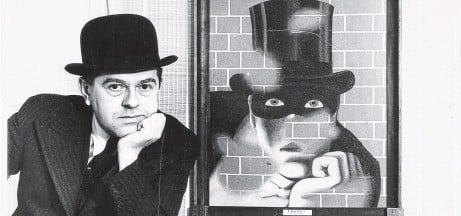
Later, his work was so popular that even if a thief stole one of his paintings, it would be too recognizable to sell.
7. Distraction Turned into Affair – Magritte’s Plot Gone Wrong
A fun fact about Rene Magritte’s love life has to be this one.
Magritte’s great love, Georgette Berger, was a key figure in his life.
They married in 1922, but Magritte’s mischievous side and his ability to manipulate others were as apparent in his romantic life as in his art.
During the time he was seeing Sheila Legg, a young artist, he once sent a friend, Paul Colinet, to distract his wife.
Unexpectedly, this ‘distraction’ set up by Magritte turned into an attraction and an actual affair between his wife and friend.
Matters became so worse that Georgette even demanded separation.
Nonetheless, once Georgette and Magritte smoothed things and got back together, they remained together for the rest of their lives until death separated them.
8. Amateur Photographer and Filmmaker
Magritte was a keen amateur photographer and filmmaker. He was also known to enjoy experimenting with photography in his leisure time.
While his photographs were never regarded with the same reverence as his paintings, they did have a role to play in inspiring his later works.
One of his foremost interests other painting was filmmaking. He even acted in some homemade films.
9. He Influenced Many Forms of Art
Magritte’s influence continues to resonate in the art world today. He has left behind many objects which have become iconic in his art.
Magritte’s endowing objects with new meanings by removing them from their ordinary contexts is a technique that has influenced contemporary artists.
Famously influenced people by René Magritte are Neo Rauch, L. S. Lowry, Paul Nash, Marcel Broodthaers, etc.
He would no doubt be delighted by the fact that many genres like pop, minimalism, conceptual art owe this trademark to the artist.
10. Unfinished Painting
Art, as I understand it defies psychoanalysis…I take care to only paint pictures that evoke the mystery of the world…No sensible man believes that psychoanalysis could explain the mystery of the world.
~ Rene Magritte
The life of Magritte spanned from 1898 to 1967. He died of pancreatic cancer at age 68 and left behind a work of art that was likely commissioned by a young German collector.
Years later, the pieces of one of his paintings were found under his other paintings.
—
This was all we wanted to share about the world’s one of most famous surrealist painters.
You probably don’t need to be a fan of the surrealist movement to appreciate some of its more creative pieces.
Did you enjoy reading about Rene Magritte’s life?
FAQs – René Magritte
What Is the Meaning of Ceci N’est Pas Une Pipe?
Ceci N’est Pas Une Pipe is french for “This is not a pipe”. The famous Belgian surrealist painter Rene Magritte wrote this below his famous pipe painting, The Treachery of Images.
What Is René Magritte Best Known for?
Rene Magritte is one of the most famous artists for his surrealist and thought-provoking paintings.
What Influenced Rene Magritte?
He was greatly influenced by four artists, Giorgio de Chirico, Andre Breton, Sigmund Freud, and Jack Boynton. Later, he became a very influential figure for many other artists.
Name of Famous Paintings Made by Rene Magritte?
The Treachery of Images (1929), The Lovers (1928), Golconda (1953), The Son of Man (1964), The False Mirror (1928), The Blank Signature (1965), to name a few.
Is the Treachery of Images Surrealist?
Absolutely! The Treachery of Images was painted by a very famous surrealist painter, Rene Magritte. The painting is of a pipe but still, the words “Ceci N’est Pas Une Pipe” (meaning “This is not a pipe”) are written below the pipe.
Who Made the Famous Pipe Painting?
Rene Magritte painted the famous pipe painting, The Treachery of images. The most famous yet perplexing work of art in history is a pipe painting that is not certain to be a pipe.
Where Was René Magritte Born?
He was born on November 21, 1898, and Rene Magritte’s birthplace was Lessines, Belgium. He was born in the province of Hainaut to Leopold Magritte and Regina.
Where Did Rene Magritte Live?
Rene Magritte has spent most of his life in Brussels. He has been a very important figure in the Belgium art world, and one of the artists that have had a great influence on the surrealist movement.
Where Did Rene Magritte Die?
Rene died in Brussels in 1967, at the age of 68. He was buried in Schaerbeek Cemetery, Brussels. He had worked until his death and also left an unfinished painting.
